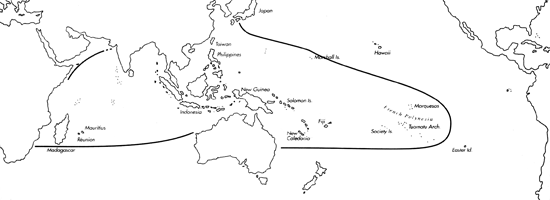Range: Entire Indo-Pacific, excetpt for Hawaii.
Description: Moderately small to moderately large, moderately light to moderately solid. Last whorl usually cylindrical, sometimes ovate, ventricosely conical or conoid-cylindrical; outline straight and parallel-sided adapically to uniformly convex; left side concave at base. Shoulder indistinct to rounded. Spire of moderate height to high, outline convex. Larval shell paucispiral in Sri Lanka (Kohn, 1961 b), of about 2.5 whorls in Philippines specimens, and of 3 or more whorls in specimens from Samoa; maximum diameter 0.6-0.7 mm. First 4-7 postnuclear whorls tuberculate. Teleoconch sutural ramps flat to slightly convex, with 0-1 increasing to 3-7 spiral grooves and often granulose strong ribs between; spiral sculpture sometimes very weak on last ramps. Last whorl with distinct, often granulose, closely spaced spiral ribs from base to shoulder.
| Shell Morphometry | ||
|---|---|---|
| L | 27-60 mm | |
| RW | 0.07-0.25 g/mm | |
| (L 27-44 mm) | ||
| RD | 0.52-0.65 | |
| PMD | 0.66-0.84 | |
| RSH | 0.16-0.26 | |
Ground colour white to pale blue, suffused with blue or violet. Last whorl variably encircled with 2-3 bluish-brown bands, leaving light zones of different shades of grey, blue, violet or brown, occasionally overlaid with brown or blue axial streaks. Base usually dark violet. Larval shell and first 4-5 postnuclear sutural ramps pink to orange. Aperture light blue behind a violet marginal zone.
Periostracum grey or brown, thin to thick, and translucent to opaque, with spiral ridges on last whorl and along shoulder edges (Cernohorsky, 1964; Kohn, unpubl. observ.).
Dorsum of foot bright red, may be dotted with white. Sole of foot and rostrum rose to orange red; tentacles white with black tips. Siphon red, dotted with white or mottled with black distally and dorsally (Pl. 76, Fig. 54; Pl. 83, First row, left) (Kohn, 1978, unpubl. observ.; Chaberman, pers. comm., 1981).
Habitat and Habits: Shallow subtidal to about 30 m. In Fiji, under corals on reefs. In New Caledonia, on debris, shell sand and dead corals in 2- 10 m. In the E. Indian Ocean, on subtidal coral reef platforms and reef slopes (Cernohorsky, 1964; Kohn, 1960; Kohn & Nybakken, 1975; Tirard, 1989, pers. comm.). In the Indian Ocean, the species is known to feed on Eunicidae and is vermivorous in the Tuamotu Archipelago as well (Kohn. 1960; Kohn & Nybakken, 1975; Salvat & Rives, 1980). In Sri Lanka, egg capsules are deposited in clusters of about 33, lack confluent basal plates, and measure 7-7.5 x 6-6.5 mm. Observed number of eggs per capsule is 37-53 and number of eggs per egg mass 1,600. An egg diameter of about 440 µm in the N. Indian Ocean predicts a minimum planktonic period of only 3 days. In Palau, the eggs measure only 341 µm in diameter, and the minimum planktonic period lasts about 11 days. Narrow larval shells of 2.5 to 3 or more whorls in Philippine and Samoan shells also predict the hatchling to be a veliger (Kohn, 1961 ; Perron & Kohn, 1985).
Discussion: C. glans is most similar to C. tenuistriatus and C. coffeae. For comparison, see the Discussions of those species.

C. glans range map
This section contains verbatim reproductions of the accounts of 316 species of Conus from the Indo-Pacific region, from Manual of the Living Conidae, by Röckel, Korn and Kohn (1995). They are reproduced with the kind permission of the present publisher, Conchbooks.
All plates and figures referred to in the text are also in Röckel, Korn & Kohn, 1995. Manual of the Living Conidae Vol. 1: Indo-Pacific Region.
The range maps have been modified so that each species account has it own map, rather than one map that showed the ranges of several species in the original work. This was necessary because each species account is on a separate page on the website and not confined to the order of accounts in the book.